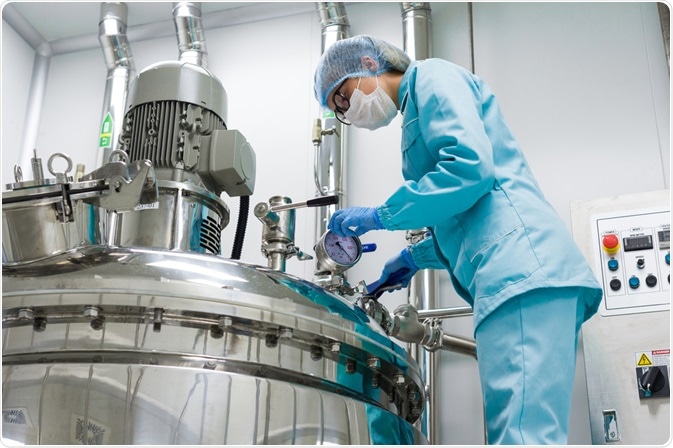Industrial chemicals are used in a multitude of processes that impact every area of human society, from the food and drug industries to the chemicals industry to construction. However, processes to produce these chemicals can create harmful by-products and, therefore, scientists are turning to other technologies to produce them.
 Image Credit: TRMK / Shutterstock.com
Image Credit: TRMK / Shutterstock.com
This article will provide an overview of common industrial chemicals, industrial microbiology, and a piece of recent research into one of the ways that scientists are producing industrial chemicals with microorganisms.
Industrial Chemistry – A Brief Overview
The global chemical industry is vast. In 2017, the total revenue worldwide was US $4.25 Trillion. In the US alone, exports to Canada and Mexico accounted for US $43.1 billion. In Europe, the chemical industry accounts for around 7% of total industrial production. China is the largest global chemical producer, accounting for 35.3% of total sales in the same year. A multitude of companies are involved in the industry, including BASF SE, Azko Nobel, and SABIC.
Commonly produced chemicals include oxygen, nitrogen, phosphoric acid, sulfuric acid, chlorine, ethylene, sodium carbonate, urea, ethanol, ethylene, acetone, and methanol. These have many applications. For example, sodium carbonate is used in glass manufacture, urea is used in cattle feed and fertilizer, phosphoric acid is utilized in the food industry and to produce fertilizer, ethanol is used for fermentation and other industrial processes.
Traditionally, the processes for manufacturing these useful products have been expensive, time-consuming, and potentially harmful.
There are many more chemicals produced besides this. With the increasing global demand which comes with industrialization and population growth, scientists working within the field of industrial chemistry are constantly looking for cheaper, more efficient, and sustainable methods of production.
Industrial Microbiology
Biotechnology is a science that has been explored in recent decades to provide the industrial chemistry industry with products and solutions, and microbes are one of these solutions. As well as being easily and readily available and cheap to produce, they are sustainable and any remaining “spent” biomass can be utilized in other industries.
Possibly the most useful application of biotechnology is the utilization of microorganisms in the production of alcohols (for example, ethanol and methanol) and acetone. These chemicals have widespread uses. The fermentation of sugars by microorganisms has been used to produce alcohol for thousands of years. These chemicals have many uses within modern industry including biofuel production.
The use of microorganisms in industrial processes is known as industrial microbiology. The field has been revolutionized along with other applications of microbiology by the advent of genetic engineering. Scientists can manipulate microorganisms such as bacteria and fungi at the genetic level to produce new tailor-made strains that can produce a multitude of chemical products.
In recent years there has been a plethora of research that has used microorganisms in surprising ways.
Exploiting microbial hyperthermophilicity to produce industrial chemicals
Renewable feedstocks such as plant biomass can be used to provide sugars for microorganisms to produce useful chemicals. However, using photosynthetic microorganisms can be problematic as photosynthesis has a low overall efficiency and sugar intermediates can prove to be wasteful as there is no benefit to them.
Alternatively, non-biomass sources can be used to turn carbon dioxide into these products. Hydrogen gas and electricity are especially useful in this regard.
Whilst microorganisms can be manipulated to produce industrial chemicals and fuels from organic substrates, there is little research on engineering them to use carbon dioxide and hydrogen gas. A team led by Matthew W. Keller demonstrated a method to do just this in a 2013 paper.
The microorganism that the team used was Pyrococcus furiosus. This is an archaeon that has an optimal growth temperature on carbohydrates of 100oC. By using a temperature-dependent approach, they managed to confer upon this microorganism the ability to directly use carbon dioxide, which it does not do naturally.
This was achieved by engineering P. furiosus in a specific way by heterologous expression of 5 carbon fixation cycle genes of Metallosphaera sedula, an archaeon that grows at 73oC. The result was that this engineered strain of P. furiosus was able to incorporate CO2 into 3-hydroxypropionic acid using hydrogen gas. This acid is one of the 12 “building blocks” of industrial chemicals. Both cell-free extract and whole cells of the recombinant strain could accomplish this.
The process is also able to be carried out at 30oC lower than P. furiousus’ optimal growth temperature. The process could sustain metabolic activity for the production of 3-hydroxypropionate with minimal growth. The team demonstrated that this could be expanded to produce other industrial chemicals.
In Conclusion
The application of microorganisms to the production of useful industrial chemicals is still a fairly recent scientific development that can solve many problems inherent to the industrial chemical industry. With research such as that illustrated above, industrial microbiology is at the cutting edge of research to provide sustainable solutions for the field of industrial chemistry.
Sources
Najafpour, G.D. (2007) Biochemical Engineering and Biotechnology (Chapter 1 – Industrial Microbiology) pp. 1-13 [Accessed Online 15th November 2020] https://www.sciencedirect.com/science/article/pii/B978044452845250001X
Keller, M.W. et al (2013) Exploiting microbial hyperthermophilicity to produce an industrial chemical, using hydrogen and carbon dioxide Proc Natl Acad Sci USA 110(15) pp. 5840-5845 [Accessed Online 15th November 2020] https://www.ncbi.nlm.nih.gov/pmc/articles/PMC3625313/
Market.us (website) 2019 – Chemical Industry Statistics and Facts [Accessed Online 15th November 2020] https://market.us/statistics/chemical-industry/